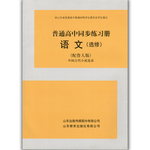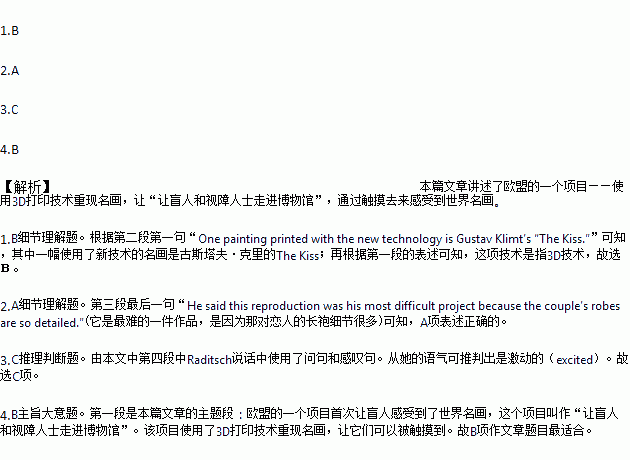题目内容
A European Union program is letting blind people experience famous paintings for the first time. It uses three dimensional(3-D) printing to re-create famous paintings so they can be touched.
One painting printed with the new technology is Gustav Klimt’s “The Kiss.” It is a popular attraction at the Belvedere Museum in Vienna, Austria. The painting shows a man and a woman standing in a field filled with flowers. They are wearing gold robes and have their arms around each other. The man leans down to kiss the woman.
Klimt finished the painting in 1908. Until now, people who had trouble seeing could not appreciate the artwork. But thanks to the reproduction they can touch the piece and feel the ridges and depressions. Andreas Reichinger started making 3-D versions of artwork in 2010. He said this reproduction was his most difficult project because the couple’s robes are so detailed.
Dominika Raditsch is a blind museum visitor. She touched the reproduction. As she moved her hands around it she said, “Exactly, can you see these? There are so many details.” Raditsch said she can imagine what the original painting looks like when she touches the reproduction. “It’s somehow round. You can feel it. You can feel it. It comes with it. And in many places it’s so smooth. And then I think to myself: it probably shines too!” Raditsch said.
The Belvedere is not the only museum to have 3-D versions of its artwork. Some of the pieces at the Prado, in Madrid, Spain, have reproductions that can be touched. But the piece in Vienna has one special part: It is made with widely available 3-D printing technology. That means one day, blind art fans anywhere in the world could download the source files and print the reproductions themselves.
1.What is “The kiss”?
A. A European Union project. B. A popular painting.
C. A 3-D technology. D. A famous museum.
2.Why did Reichinger say this reproduction was difficult to finish?
A. The painting was reproduced detailed.
B. The original artwork was made in 1908.
C. Blind art fans can’t download the source.
D. The 3-D technology is not available.
3.How did Raditsch feel when she first touched the reproduction?
A. Awkward. B. Puzzled.
C. Excited. D. Nervous.
4.What is the best title for the text?
A. A European Union Program for Museum Visitors
B. 3-D Printing Lets Blind Experience Famous Painting
C. How to Reproduce the World-famous Paintings
D. A Special Museum for Art Fans in Vienna, Austria
 海淀黄冈名师导航系列答案
海淀黄冈名师导航系列答案 普通高中同步练习册系列答案
普通高中同步练习册系列答案
